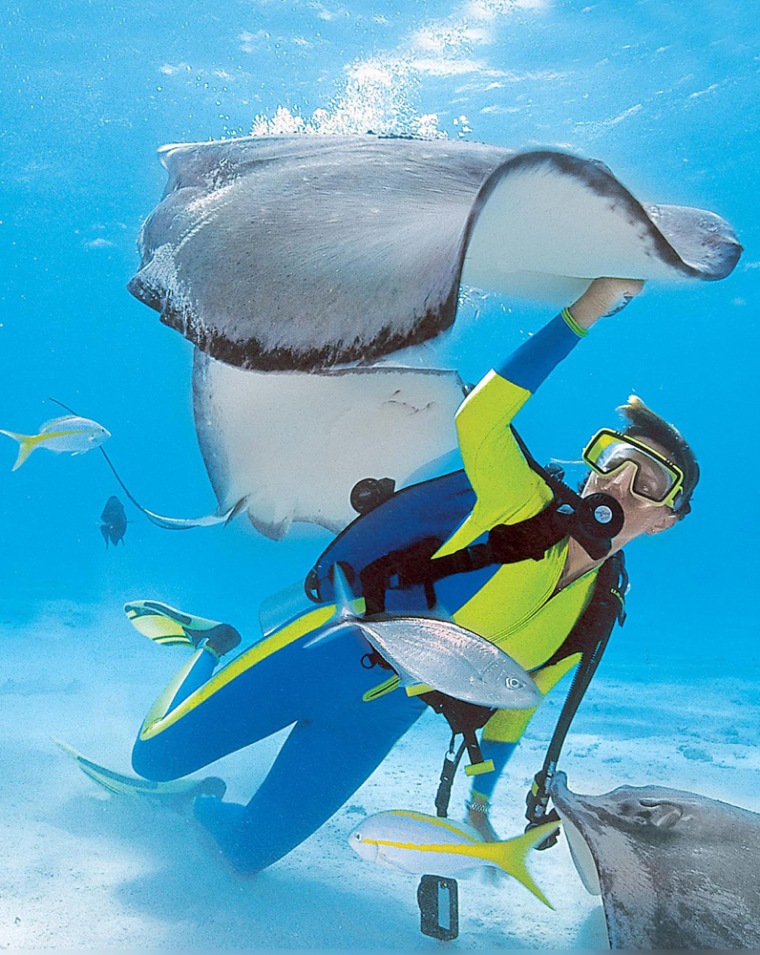When Christopher Columbus saw the generally flat and low-lying Cayman Islands in 1503, it was no doubt the island of Cayman Brac that he sighted first. Its most distinguishing feature is "The Bluff," a limestone crag that rises 140 feet above the Caribbean Sea at the eastern tip of this island. "Brac" is a Gaelic word for crag, hence the island's name.
Cayman Brac - already well-known for its excellent diving opportunities - is being promoted as an all-around ecotourism destination, and The Bluff is part of the attraction. It provides a challenge to rock climbers and hikers, and nature-lovers will want to visit the protected Cayman Parrot Preserve located at the top.
The bluff is also pockmarked with numerous caves housing thousands of bats, an important component of the island's fragile ecosystem. In addition, the caves play an important role as shelters for island residents during hurricane season. "Brackers," as they are called, have traditionally sought sanctuary in these pockets in the limestone.
Cayman Brac was fortunate to have survived Hurricane Ivan with minimal damage, unlike its more populated and developed "Sister Island," Grand Cayman, where the storm destroyed 70 percent of the buildings, including most tourist facilities.
But initial weather reports showed Ivan, a category five storm, as heading straight for Cayman Brac and the third of the Sister Islands, Little Cayman. The forecast led many locals to seek shelter from Ivan in the caves. Among them was Tenson Scott, 68, a retired seaman, and his wife, Starrie, of Spot Bay, who headed to Peter's Cave on the eastern end of the island.
"It's the safest place in the Brac to be," Tenson said. "Even if Ivan had come here, he couldn't touch the people in the caves."
Scott said there were about 40 people, including a half-dozen children, holed up in Peter's Cave. He and his wife Starrie entered the cave through an entrance reached by a wooden stairway that ascends about 60 feet up the side of The Bluff on Sept. 10 and emerged Sunday afternoon after Ivan had passed. Corned beef, sandwiches, biscuits and canned tuna provided sustenance.
Asked if they were scared, he said, "No ma'am!"
Lance Boley, 46, a contractor, and his wife, Kathleen, sat out Ivan in a 700- to 800-square-foot cave on the island's south shore. They brought 72 gallons of water, 200 pounds of food and even set up a kitchen with a Coleman stove and spice rack. A bathroom was set up in an alcove, complete with a five-gallon bucket.
"The essence of caving well is to restore a sense of normalcy," Boley explained.
The Boleys sat on mattresses in the mouth of the cave and watched the storm rage. "The winds were running parallel to the entrance, so we felt no danger," he said.
Boley said they could see waves building 30 degrees above the horizon from their perspective, "and waves building on top of those! It floored us," he said.
At a news conference in New York City on Sept. 29, Cayman Chief Minister McKeeva Bush said that diving destinations off the smaller islands appear to have actually been enhanced by the storm.
"For many of our repeat divers, nature has given us a lot of new experiences to discover," he said. The storm cleared out algae and created new swim-through areas in underwater walls, he added.
Both Cayman Brac and Little Cayman are regularly ranked among the best dive locations in the world by readers of Scuba Diving magazine. Excellent visibility, abundant sea life - including sharks, turtles, rays and coral - and a water temperature of around 85 degrees in winter are all part of the appeal. An underwater cliff can be found about 70 to 80 feet down; a Russian destroyer sunk for divers to explore is also popular.
Air service to the smaller islands generally includes a transfer on Grand Cayman. Despite the storm's devastating hit on the big island, the airport there has been reopened and fully operational, and Cayman Airways is expected to proceed as originally planned with new service from Boston, beginning December 2004, Bush said.
Cayman Brac has a population of under 1,300 on an island about 2 miles by 2 miles. Little Cayman is smaller still, with under 170 residents on a 10-mile-by-1-mile island, adding to the feeling of remoteness treasured by many vacationers.
If you go:
CAYMAN ISLANDS: Visit www.caymanislands.ky
AIR SERVICE: Visit www.caymanairways.com
